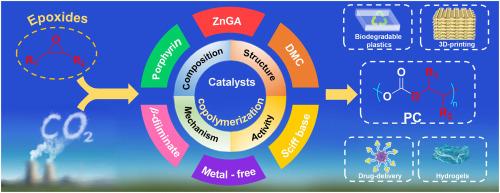A review on catalytic copolymerization of carbon dioxide and epoxides
IF 7.9
3区 材料科学
Q1 GREEN & SUSTAINABLE SCIENCE & TECHNOLOGY
引用次数: 0
Abstract
The catalytic copolymerization of carbon dioxide (CO2) and epoxides represents a paradigmatic strategy for carbon valorization, simultaneously addressing the imperative of greenhouse gas mitigation and the sustainable production of advanced polymeric materials. As an inherently atom-economical and energy-efficient transformation, this process affords aliphatic polycarbonates (PCs) with tunable architectures and high CO2 incorporation, offering significant environmental and industrial benefits. However, the intrinsic thermodynamic stability of CO2, alongside the kinetic inertness of epoxides, necessitates the development of highly active, selective, and robust catalytic systems capable of suppressing side reactions such as cyclic carbonate and polyether formation. This review critically examines the evolution of heterogeneous and homogeneous catalytic platforms, including well-defined metal complexes, multinuclear architectures, and emerging organocatalytic systems, unpacking the intricate interplay between electronic effects, steric modulation, and cooperative mechanisms in catalyst design. Furthermore, this review elucidates current limitations in catalyst stability, process scalability, and impurity tolerance, proposing forward-looking strategies such as dynamic ligand frameworks, heterobimetallic pairing, and macromolecular catalyst architectures to overcome these bottlenecks. By integrating mechanistic insights, material performance considerations, and sustainable process engineering principles, this contribution aims to the rational design for next-generation catalytic systems in CO2-based polymer chemistry.

二氧化碳与环氧化物催化共聚的研究进展
二氧化碳(CO2)和环氧化物的催化共聚代表了碳增值的典范战略,同时解决了温室气体减排和先进聚合物材料可持续生产的必要性。作为一种固有的原子经济和节能转化,该工艺提供了具有可调结构和高二氧化碳掺和的脂肪族聚碳酸酯(pc),具有显着的环境和工业效益。然而,二氧化碳固有的热力学稳定性,以及环氧化物的动力学惰性,需要开发高活性,选择性和强大的催化体系,能够抑制副反应,如环碳酸盐和聚醚的形成。本文回顾了多相和均相催化平台的发展,包括定义明确的金属配合物、多核结构和新兴的有机催化系统,揭示了催化剂设计中电子效应、空间调节和合作机制之间复杂的相互作用。此外,本文还阐述了目前催化剂稳定性、工艺可扩展性和杂质耐受性方面的局限性,并提出了诸如动态配体框架、杂双金属配对和大分子催化剂结构等前瞻性策略来克服这些瓶颈。通过整合机理见解、材料性能考虑和可持续工艺工程原则,这一贡献旨在为基于二氧化碳的聚合物化学的下一代催化系统进行合理设计。
本文章由计算机程序翻译,如有差异,请以英文原文为准。
求助全文
约1分钟内获得全文
求助全文
来源期刊

Materials Today Sustainability
Multiple-
CiteScore
5.80
自引率
6.40%
发文量
174
审稿时长
32 days
期刊介绍:
Materials Today Sustainability is a multi-disciplinary journal covering all aspects of sustainability through materials science.
With a rapidly increasing population with growing demands, materials science has emerged as a critical discipline toward protecting of the environment and ensuring the long term survival of future generations.
 求助内容:
求助内容: 应助结果提醒方式:
应助结果提醒方式:


